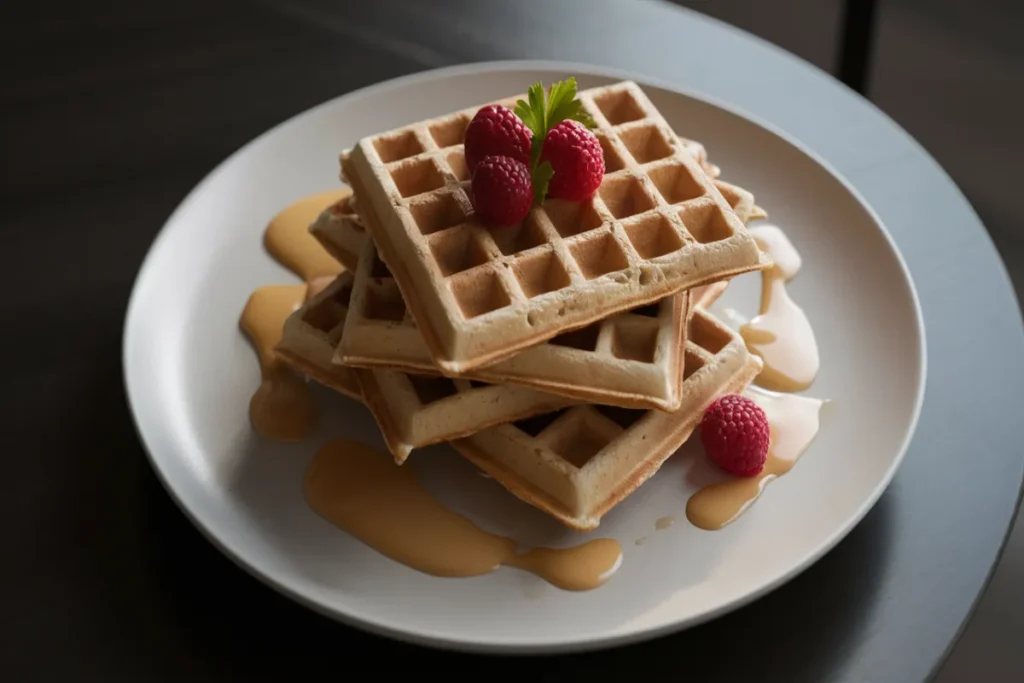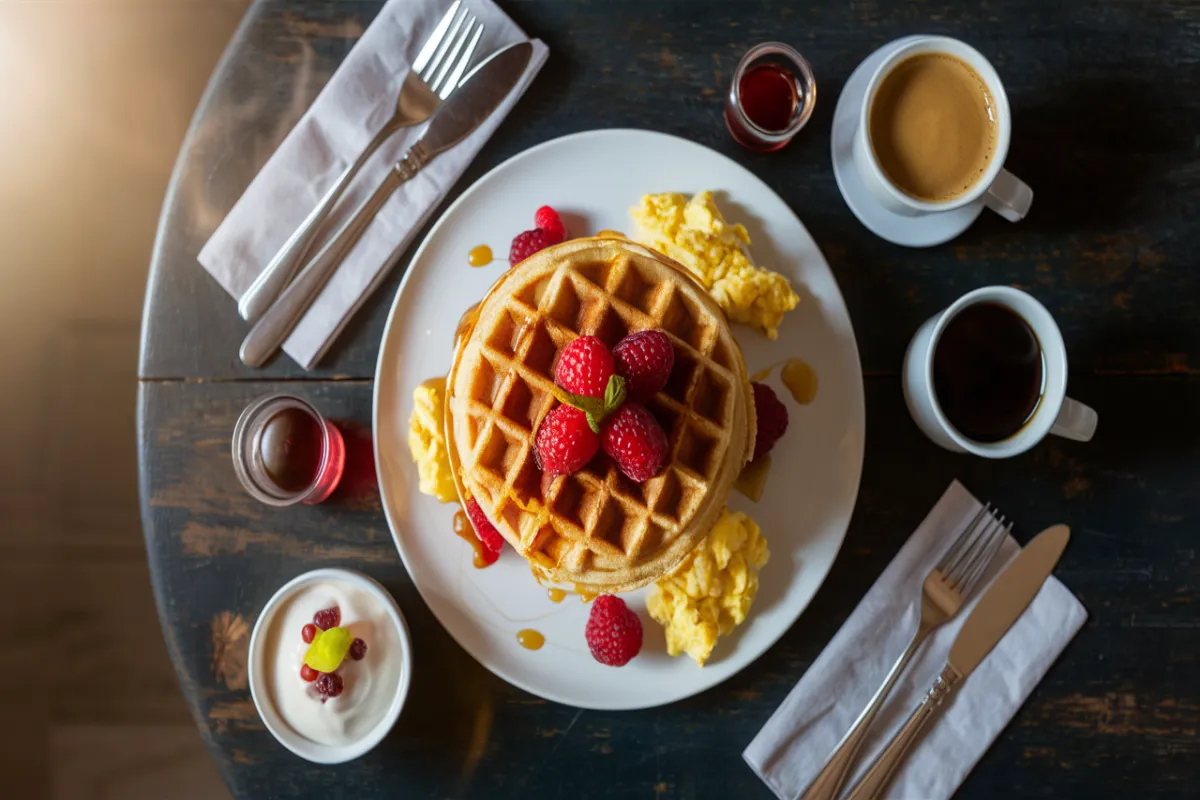Starting your day with a satisfying, delicious, and balanced meal is crucial for keeping your energy high and making the most out of your day. When looking for a meal that fits specific dietary needs, a gluten free breakfast is a versatile option, allowing for a range of ingredients that provide nourishment without sacrificing flavor. This comprehensive recipe will guide you through the steps of creating a delicious gluten free breakfast, complete with ingredient explanations, tips, tricks, and variations to help you master it. This breakfast recipe will quickly become a staple in your household due to its adaptability, flavor, and ease.
Ingredients for Gluten Free Breakfast

Each ingredient in this gluten free breakfast recipe has been carefully selected to provide the best flavor and texture while keeping the meal completely free from gluten. Below, you’ll find a detailed explanation of each ingredient and its role in this breakfast, as well as possible substitutions that you can use to personalize it according to your preferences.
1. Gluten Free Flour (1 cup)
Gluten-free flour is the foundation of this breakfast, especially if you are making pancakes, waffles, or muffins. There are many gluten-free flour blends available, typically made from a combination of rice flour, potato starch, tapioca starch, and xanthan gum. Xanthan gum provides elasticity and helps mimic the structure of gluten. Substitution: Almond flour, oat flour, or buckwheat flour can be used, but they may alter the texture slightly.
2. Eggs (2 large)
They are essential for binding the ingredients together, adding moisture and providing structure to the batter, whether you’re making gluten-free pancakes or a breakfast casserole. Eggs also give the meal richness and help create a fluffy texture. Substitution: For a vegan alternative, use a flax egg (1 tablespoon ground flaxseed mixed with 3 tablespoons water).
3. Milk (1 cup)
Milk is used to thin the batter and create the desired consistency. It also adds creaminess and enhances the flavor. You can use regular cow’s milk or any plant-based milk like almond, coconut, or oat milk. Substitution: Any non-dairy milk like soy, cashew, or hemp can be used as a one-to-one replacement.
4. Baking Powder (1 tablespoon)
Baking powder acts as a leavening agent that helps your gluten-free breakfast rise, giving it a light and fluffy texture. It’s particularly important in pancakes, waffles, and muffins. Substitution: Make sure to use gluten-free baking powder if you’re sensitive to gluten. If you don’t have baking powder on hand, you can substitute it with ¼ teaspoon baking soda and ½ teaspoon of lemon juice or vinegar.
5. Salt (½ teaspoon)
Salt enhances the flavor of the gluten free breakfast, balancing sweetness and savory notes. It is important not to skip this, as it brings out the natural flavors of the other ingredients. Substitution: Sea salt or kosher salt can be used instead of regular table salt.
6. Sugar (1 tablespoon)
Sugar adds sweetness and balances the flavors. It also helps with the browning of baked goods like gluten-free pancakes or muffins. You can adjust the amount of sugar depending on your taste. Substitution: Coconut sugar, honey, maple syrup, or a sugar substitute can be used to sweeten the breakfast to your liking.
7. Butter or Oil (2 tablespoons)
Butter adds richness and flavor to your gluten-free breakfast, making it indulgent. If you’re dairy-free, you can substitute the butter with coconut oil or a neutral oil like avocado oil. Substitution: Olive oil, ghee, or vegan butter can also work, depending on the recipe.
8. Fresh Fruit or Berries (1 cup)
Fresh fruit like blueberries, strawberries, or bananas are perfect for mixing into batters or serving alongside your gluten free breakfast. They add natural sweetness, flavor, and a pop of color to your meal. Substitution: Frozen fruit works well too; just thaw it beforehand, or dried fruits like raisins and cranberries can be used for added texture.
9. Gluten-Free Oats (1 cup)
Gluten-free oats add texture and heartiness to many breakfast recipes, such as oatmeal, porridge, or granola. They are also a great option for making a nutritious breakfast bowl. Substitution: Quinoa flakes, buckwheat groats, or puffed rice cereal can be used as an alternative to oats.
Step-by-Step Guide to Prepare Gluten-Free Breakfast
This step-by-step guide will walk you through creating the perfect gluten free breakfast, whether you’re in the mood for pancakes, waffles, or muffins. Additionally, you’ll find instructions for a gluten-free breakfast casserole that’s ideal for meal prep or larger gatherings.
Step 1: Gather Your Ingredients
Before you start cooking, ensure that all your ingredients are pre-measured and ready to go. This will streamline the cooking process and therefore make it easier for you to focus on perfecting the dish.
Step 2: Prepare the Batter
In a large bowl, whisk together your dry ingredients – gluten-free flour, baking powder, sugar, and salt. Meanwhile, in a separate bowl, whisk the eggs and milk until smooth. Then, melt the butter or oil and add it to the wet mixture. Combine the wet and dry ingredients, stirring just until combined. However, be careful not to overmix the batter, as this can make the final product dense.
Step 3: Add Your Mix-Ins
If you are incorporating fresh fruit, oats, or any other mix-ins, gently fold them into the batter now. For instance, add blueberries to pancake or muffin batter or stir gluten-free oats into a breakfast bowl base. Thus, your gluten free breakfast will have added texture and flavor.
Step 4: Cook the Breakfast Items
Depending on the dish you’re making, your cooking method will vary:
- For Pancakes: Preheat a non-stick skillet over medium heat and lightly grease it. Pour batter onto the skillet and cook until bubbles form on the surface and the edges start to look set, about 2-3 minutes per side. Flip and cook until golden brown.
- For Waffles: Preheat your waffle iron and lightly grease it. Pour the batter into the preheated iron and cook according to the manufacturer’s instructions, typically 4-5 minutes.
- For Muffins: Preheat your oven to 350°F (175°C) and grease a muffin tin or line it with paper cups. Divide the batter evenly among the cups, filling them about two-thirds full. Bake for 18-20 minutes, or until a toothpick inserted into the center comes out clean.
- For a Breakfast Casserole: Grease a casserole dish and preheat your oven to 375°F (190°C). Pour the prepared batter or mixture into the dish, spreading it evenly. Bake for 25-30 minutes or until the top is golden and the center is set.
Step 5: Serve Your Gluten-Free Breakfast

Once your gluten-free breakfast is cooked, remove it from the heat or oven and allow it to cool slightly. Serve warm with your desired toppings or side dishes. Meanwhile, feel free to garnish with extra fresh fruit, syrup, or a dollop of yogurt for a balanced, flavorful breakfast.
Tips and Tricks for the Best Gluten-Free Breakfast
Creating the best gluten free breakfast doesn’t have to be challenging. With that said, here are some tips and tricks to ensure that your meal turns out perfectly every time.
- Don’t Overmix the Batter: Overmixing can lead to dense, tough results. Instead, stir just until the ingredients are combined for a light, fluffy texture.
- Check Your Baking Powder: Always ensure your baking powder is fresh. Otherwise, your gluten-free breakfast won’t rise properly, leaving it flat and dense.
- Grease Your Pans Properly: Gluten free batters can be sticky, so always grease your pans or molds well. Thus, this will ensure easy release after cooking.
- Be Creative with Substitutions: Feel free to get creative with substitutions, using different fruits, oils, and flavorings to customize it. For instance, adding nuts, seeds, or spices like cinnamon can elevate the dish.
Serving Suggestions for Gluten Free Breakfast
A gluten free breakfast can be served in various ways depending on the occasion. Additionally, it pairs well with numerous side dishes, allowing you to create a complete and satisfying meal.
For a Simple Breakfast:
Serve your gluten free pancakes, waffles, or muffins with a drizzle of maple syrup and a side of fresh fruit. As a result, you’ll have a classic and easy breakfast that’s perfect for any day of the week.
For Brunch:
Create a brunch spread by offering a variety of gluten-free breakfast options such as pancakes, breakfast casserole, fresh fruit salad, and yogurt parfaits. Moreover, you can serve coffee, tea, and fresh juices alongside the spread.
For a Special Occasion:
For special occasions, consider serving your gluten-free breakfast with more indulgent toppings like whipped cream, chocolate chips, or homemade fruit compote. Furthermore, set up a topping bar where guests can customize their breakfast as they wish.
Pairing Suggestions
Pairing your gluten free breakfast with the right beverages and sides can elevate the experience. Here are a few pairing suggestions:
- Coffee or Tea: A warm cup of coffee or tea complements the richness of the breakfast. Additionally, flavored teas or coffee with milk add a nice contrast to sweet breakfast dishes.
- Fresh Juices: For a refreshing option, pair your gluten free breakfast with a glass of orange juice, apple juice, or a fresh green juice. Thus, the bright flavors help balance the sweetness and richness of the meal.
- Smoothies: Smoothies packed with fresh fruits and greens are a nutritious and flavorful pairing option. Moreover, adding yogurt or protein powder can make your smoothie more filling.
Frequently Asked Questions (FAQs)
1. Can I make a gluten free breakfast without eggs?
Yes, you can make it without eggs. For example, in pancake or waffle recipes, substitute eggs with flax eggs (1 tablespoon ground flaxseed mixed with 3 tablespoons water). Additionally, applesauce or mashed bananas can be used as an egg substitute.
2. Can I prepare a gluten free breakfast in advance?
Absolutely! You can prepare many breakfast items like muffins, pancakes, or waffles in advance. Simply store them in an airtight container at room temperature for a day or refrigerate for up to 3 days. To reheat, warm them in the oven or toaster for a few minutes.
3. How do I store leftover gluten free breakfast items?
To store leftover gluten-free breakfast items, let them cool completely before placing them in an airtight container. Next, refrigerate for up to 3 days or freeze for up to 3 months. Thus, when you’re ready to eat them, reheat directly from the fridge or freezer.
4. Can I use almond flour ?
Yes, almond flour is a great substitute for this recipe flour in many breakfast recipes. However, almond flour can change the texture, making it denser and more moist. Therefore, it may require adjusting the other ingredients slightly.
5. Can I freeze gluten free breakfast items?
Yes, you can freeze many breakfast items such as pancakes, waffles, and muffins. Once cooled, wrap them individually in plastic wrap and place them in a freezer-safe bag. To reheat, pop them in the toaster or oven until heated through.
Conclusion
This gluten free breakfast recipe is incredibly versatile, allowing for countless variations depending on your tastes and preferences. From pancakes and waffles to muffins and casseroles, it proves that delicious meals can be enjoyed by everyone, regardless of dietary restrictions. Furthermore, it can be served in many different ways, making it a fantastic option for daily meals or special occasions. So, whether you’re preparing breakfast for yourself, your family, or a crowd, this recipe will ensure that everyone is satisfied, comforted, and eager for seconds.

